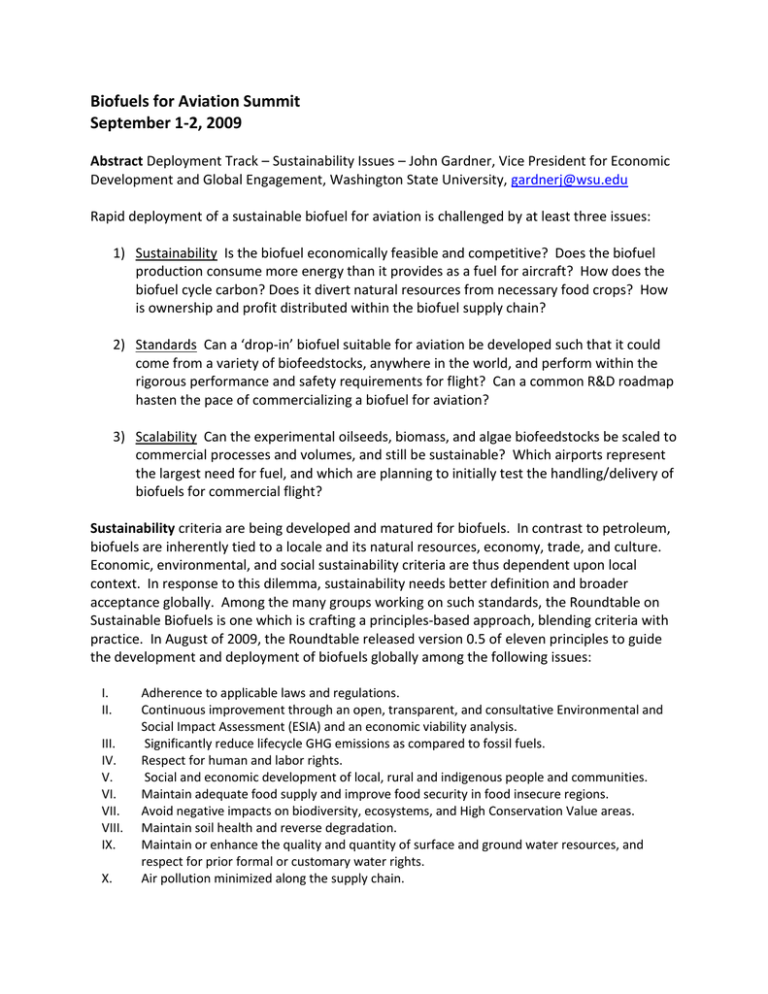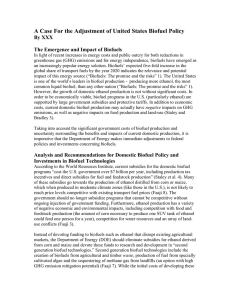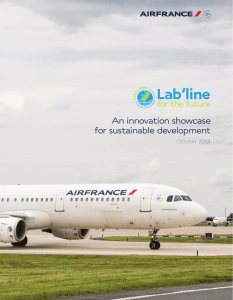Biofuels for Aviation Summit September 1
advertisement

Biofuels for Aviation Summit September 1-2, 2009 Abstract Deployment Track – Sustainability Issues – John Gardner, Vice President for Economic Development and Global Engagement, Washington State University, gardnerj@wsu.edu Rapid deployment of a sustainable biofuel for aviation is challenged by at least three issues: 1) Sustainability Is the biofuel economically feasible and competitive? Does the biofuel production consume more energy than it provides as a fuel for aircraft? How does the biofuel cycle carbon? Does it divert natural resources from necessary food crops? How is ownership and profit distributed within the biofuel supply chain? 2) Standards Can a ‘drop-in’ biofuel suitable for aviation be developed such that it could come from a variety of biofeedstocks, anywhere in the world, and perform within the rigorous performance and safety requirements for flight? Can a common R&D roadmap hasten the pace of commercializing a biofuel for aviation? 3) Scalability Can the experimental oilseeds, biomass, and algae biofeedstocks be scaled to commercial processes and volumes, and still be sustainable? Which airports represent the largest need for fuel, and which are planning to initially test the handling/delivery of biofuels for commercial flight? Sustainability criteria are being developed and matured for biofuels. In contrast to petroleum, biofuels are inherently tied to a locale and its natural resources, economy, trade, and culture. Economic, environmental, and social sustainability criteria are thus dependent upon local context. In response to this dilemma, sustainability needs better definition and broader acceptance globally. Among the many groups working on such standards, the Roundtable on Sustainable Biofuels is one which is crafting a principles-based approach, blending criteria with practice. In August of 2009, the Roundtable released version 0.5 of eleven principles to guide the development and deployment of biofuels globally among the following issues: I. II. III. IV. V. VI. VII. VIII. IX. X. Adherence to applicable laws and regulations. Continuous improvement through an open, transparent, and consultative Environmental and Social Impact Assessment (ESIA) and an economic viability analysis. Significantly reduce lifecycle GHG emissions as compared to fossil fuels. Respect for human and labor rights. Social and economic development of local, rural and indigenous people and communities. Maintain adequate food supply and improve food security in food insecure regions. Avoid negative impacts on biodiversity, ecosystems, and High Conservation Value areas. Maintain soil health and reverse degradation. Maintain or enhance the quality and quantity of surface and ground water resources, and respect for prior formal or customary water rights. Air pollution minimized along the supply chain. XI. Maximize production efficiency and social and environmental performance, and minimize the risk of damages to the environment and people. Standards are being drafted and progress made based on the performance testing of Synthetic Paraffinic Kerosene (SPK) made from bio-derived oils that can be used in commercial aircraft at a blend ratio of up to 50 percent with traditional jet fuel (JetA or Jet A-1). With a preliminary standard drafted, it now is being examined and hopefully approved by the American Society for Testing and Materials (ASTM) in 2010. Adoption of these standards would move the industry toward the characterization of biofuels by performance, not feedstock. Other ‘standards’ contributing to rapid deployment are the creation of common research/development roadmaps (such as one maintained by CAAFI) helping to reduce unnecessary redundancy, rapidly disseminate lessons learned, and reduce the risk of private sector investment in the industry. Scale of the aviation industry and its fuel needs are small (<8%) compared to other modes of transportation – yet it represents a unique and compelling market and test bed for broader biofuel markets. Why? 1) Aviation must be inherently conservative with new technologies. Since there is no substitute for flight, public safety and confidence suggest aviation is the ideal candidate for development of a ‘drop-in’ biofuel – i.e., one that can replace (or exceed) petroleum jet fuel specifications without having to modify the aircraft or engines. This extends the value of the reliability and safety of existing jet propulsion systems. 2) Aviation is structured with far fewer customers (<200 airlines), a drastically smaller fleet (<30,000 planes globally), few known commercial airport/fueling stations (<1,700 in US), and few companies who assemble whole planes and serve as sector integrators. The near term goal is development of biofeedstock production (among oilseeds, biomass, algae, etc. as deemed regionally appropriate), and the processing and delivery of biofuels to commercial aviation in 2012, with production exceeding 1% of total market need by 2015. The American Association of Airport Executives (AAAE) has tentatively proposed the involvement of several U.S. airports and authorities to be involved in its environmental programs, including Metropolitan Washington Airports Authority, Hartsfield-Jackson Atlanta International Airport, Chicago O’Hare International Airport, San Francisco International Airport, Seattle-Tacoma International Airport, and the Port Authority of New York and New Jersey. Among the initiatives, these airports could be among the first to test a regionally-developed biofeedstock production, processing, delivery supply chain. 30 Busiest US Airports in 2007, FAA








